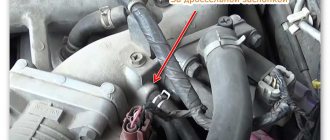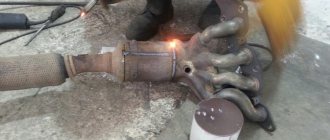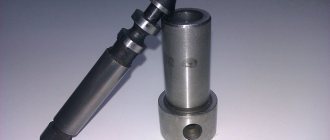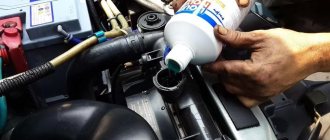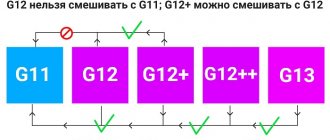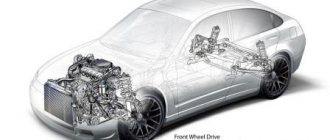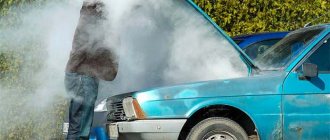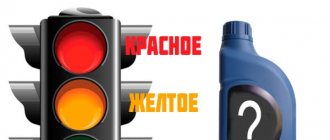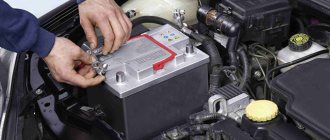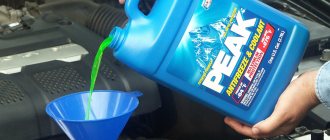Differences from antifreeze
Antifreezes are liquids that do not freeze at subzero temperatures. Coolant is poured into the vehicle's cooling system. Also, these mixtures have lubricating properties and protect metal parts from corrosion.
Antifreeze is a coolant that helps protect a car engine from harmful overheating. The boiling point of such a coolant is above 120 degrees Celsius. These liquids freeze only in critical frosts. Even an average quality mixture does not lose its properties at temperatures of -38 and below. Antifreeze allows you to use your car at any time of the year, no matter whether it is summer or winter. As for antifreeze, from a chemical point of view it is the same antifreeze, only domestic. By the way, in no other country, except for the USSR, did there exist a division of coolants into such classifications. This is a purely Soviet development.
History of the creation of TOSOL
TOSOL was developed in the Soviet Union in the late 1960s and early 1970s as a replacement for the Italian Paraflu 11 antifreeze, which was used in the cooling system of VAZ cars.
TOSOL was obtained at the State Research Institute of Organic Chemistry and Technology. Its name comes from the first letters of the name of the Department of Organic Synthesis Technologies, which led the development. The ending “OL” was added to indicate that the product belongs to alcohols - after all, the basis of TOSOL is alcohol (ethylene glycol).
The abbreviation TOSOL became a trade name, and the recipe and production technology were fixed by the Soviet GOST.
In addition to water and ethylene glycol, TOSOL contains a composition of anti-foam and anti-corrosion additives. This liquid was poured into VAZ cars coming off the assembly line, and anti-foam additives were able to ensure high-quality and quick filling of the cooling system in the factory.
TOSOL was produced strictly in accordance with GOST and in its characteristics was not inferior to the best foreign-made antifreezes.
The word TOSOL was registered as a trade name and came to mean Soviet-made antifreeze with strictly defined composition and performance properties.
In the 1990s, the production of TOSOL was discontinued.
Numerous enterprises and cooperatives under this popular trade name began to produce a variety of products with a variety of recipes. At the same time, there was simply no one to control the production and compliance of liquids with quality standards. A large number of fakes discredited TOSOL.
Currently, various companies continue to produce silicate-type coolants under the trade name “TOSOL” according to numerous Technical Specifications. The composition and properties of these products have nothing in common with the original TOSOLs produced in the USSR.
Since TOSOL was listed as the recommended coolant in the instructions for VAZ cars, many car enthusiasts still prefer to fill their cars with these antifreezes. However, it is now almost impossible to understand which TOSOL is better and which manufacturer produces the highest quality liquids.
About colored antifreezes
The product itself is colorless. The colored liquid is made from the dyes included in the composition. It is due to these substances that the coolant acquires one color or another. Antifreezes are colored so that the car enthusiast can distinguish the products from ordinary water. The basis of any coolant is ethylene glycol. It is dangerous and poisonous to humans. In addition, colored antifreeze helps identify leaks in the system. And finally, the shades indicate some of the properties and characteristics of the liquid.
The main differences between these coolants
What are the differences between traditional antifreeze and Antifreeze? First of all, it’s about - this is the same coolant only of domestic production. The history of how motorists in the post-Soviet space began to call any antifreeze “Antifreeze” goes back several decades.
Back then, under the Soviet Union, the only type of refrigerant was sold on the car market and it was called “Antifreeze”. That's where it came from. Some motorists mistakenly believe that the main difference between Russian Tosol and any other refrigerant is its blue color. However, this is not the case. The color of the consumable depends solely on the dye that is added to it, but it does not affect any performance characteristics. So the opinion that blue color is the main difference between Tosol and antifreeze is erroneous.
Adding distilled water to the expansion tank
Compound
Actually, the performance characteristics and composition of the substance are the main difference between them. Domestic coolant contains ethylene glycol and distilled water. In addition, Tosol also contains additional additives based on salts of inorganic acids. In particular, we are talking about phosphates, silicates, nitrites and nitrates.
Any antifreeze contains ethylene glycol and distillate, as well as propylene glycol and alcohol. But it is organic additives that play a key role here. Their composition is especially valuable for consumables, since these additives increase the anti-corrosion and anti-foam properties of the material.
Characteristics
"Antifreeze". As a result of the fact that a protective layer appears on the surface of the metal components of the cooling system, the thickness of which often does not exceed 0.5 mm, this affects heat transfer. It is because of this that gasoline consumption may increase, and the service life of the vehicle’s engine will be reduced. In practice, domestically produced refrigerants lose their properties after 30-40 thousand kilometers.
Pouring green coolant into the vehicle's expansion tank
Since antifreeze may contain phosphates and silicates, this coolant can form gels and deposits on the walls of the cooling system. The formation of deposits in the system can subsequently lead to clogging of the radiator and, accordingly, its failure.
Antifreeze. High-quality refrigerant forms a protective layer only on those system components that are more susceptible to corrosion. In addition, heat transfer is not disrupted, which means that the use of such coolant is safer for engine parts.
Read also: Oil for piston compressor
Antifreeze
It is traditionally blue. This is the same solution of water and ethylene glycol. As for the color, it is blue.
But today you can already find variants with a red color on sale. The difference between them is in temperature thresholds. Blue “TOSOL” does not lose its properties at temperatures down to -30. Red lasts until -40. The solution uses additives of the very first generation. They are made on the basis of phosphates, silicates and other inorganic compounds. The composition protects pipes and pipes. The service life of the liquid is no more than 3 years. Boiling point – no more than 110 degrees. It is imperative to understand the difference in what color antifreeze and antifreeze are, so that under the guise of a good product you do not purchase an ineffective liquid.
What actions should I take?
First of all, find out why antifreeze began to leak into the car oil (how to find out the reason was written above). In most cases, you need to change the lining by checking the engine parts. If the block head is in good condition and has no noticeable cracks or holes, then repairs will not be expensive. If there is severe deformation, the worn part will need to be replaced. Remember that there is no point in repairing a broken block head. It's easier to replace it with another one.
Once you have eliminated the root cause, flush the cooling and lubrication system completely. You will need to disassemble the pipes and clean the oil channels. It's quite difficult. The mixture of coolant and lubricant is not easy to remove from parts. Use cleaning products that clean the engine from various contaminants.
Curdled oil in antifreeze negatively affects engine performance. Bearings become coked, lubricant is deposited on spare parts, and the corrosive effect increases. If you ignore the problem, the power unit will jam and major repairs will be required.
When purchasing a vehicle, be prepared for the fact that you will need to carry out maintenance yourself. All recommendations are written in the operating manual. Once you understand how a car works, you are unlikely to pour antifreeze into the lubricant complex.
Such knowledge comes with experience. The more experienced the driver, the more procedures he can perform independently. This makes it possible to save your own money, since you do not need to pay car service employees for work.
Read also: Inspection pit for a passenger car dimensions
To ensure that your vehicle serves you for as long as possible, follow the recommendations prescribed by the car manufacturer in the owner's manual. Fill the engine with only those consumables that are optimal for your power unit. If you find it difficult to choose the optimal cooler/oil, contact an experienced driver or a service center employee. Proper car maintenance is a guarantee of long-term operation of the car.
As you know, coolant is an important consumable element in the system of any car. Therefore, the choice of refrigerant is a priority when replacing it. Today we will tell you how to determine whether “Tosol” or antifreeze is filled, and what are the differences between these substances.
Many experienced car enthusiasts know that optimal and efficient operation of a vehicle’s engine is ensured by high-quality coolant filled in. If the consumable material is really good, then it can extend the service life of engine components, as well as ensure their normal operation.
Antifreeze and antifreeze from various manufacturers, distilled water
What to do if you don’t know what kind of coolant (hereinafter referred to as coolant) is in your car? Determining this is not as easy as it seems at first glance.
G11: green, blue, yellow
In Russia, as in Europe, coolants are classified according to Volkswagen standards. These are G11, G12, G12+ and G13. G11 class products are most often produced in green.
But what color antifreeze is depends on the manufacturer. G11 is produced in blue (turquoise) and yellow.
This is a hybrid mixture. The composition, in addition to a solution of ethylene glycol with water, contains special additives on an inorganic basis. They are designed to protect surfaces from corrosion. These mixtures have been produced since the 90s. They do not have a long service life and are designed for all types of radiators. These fluids are poured into Mercedes, Chrysler and many others. The green version of G11 is a continuation of the development of domestic TOSOL. The latter is also equated to this class. Green liquids in the G11+ and G11++ classes are also sold. The difference between them is the percentage of carboxylic acids.
What happens if you mix TOSOL with water?
The question of whether it is possible to mix antifreeze and antifreeze with water has been worrying more than one generation of car enthusiasts.
The answer to this question is obvious, since any ready-to-use antifreeze already contains about 60 percent water.
Therefore - yes, it is possible!
However, when mixing, you should still follow some rules.
The most important condition is to use only distilled water when mixing, which contains a minimum amount of impurities.
If TOSOL concentrate is used for mixing, then you need to remember that the amount of water added greatly affects the freezing point and boiling point of the resulting antifreeze.
As you can see from the graph above, a liquid containing about 67 percent ethylene glycol and about 33 percent water will have the minimum freezing point. And a decrease in the concentration of ethylene glycol by just 10% leads to an increase in the freezing point by almost 20 degrees.
Therefore, if you need to add fluid to the system or have to completely replace antifreeze, antifreeze can be safely mixed with water. If the actual concentration of ethylene glycol differs from the recommended one, then be sure to take into account how much the working properties of the resulting TOSOL have changed.
G12: red and its shades
G12 coolants are traditionally produced in red and its shades. This is anything from pink to maroon. Experts classify this mixture as the carboxylate type. The composition contains organic additives that have a selective effect. The liquid creates a durable protective layer only on those surfaces where there are already pockets of corrosion. These antifreezes were developed in the 90s. These fluids are excellent for working with high-speed and hot engines. This composition serves no more than 5 years.
Red antifreeze G12 is used in the production of many modern Korean, American, Italian and other cars.
G13: orange, yellow
Unlike all previous types of formulations, this type is not based on ethylene glycol.
Propylene glycol is used as the base substance. This antifreeze is of higher quality, more environmentally friendly and more expensive. Beginners often ask what color antifreeze is and which is the most expensive. This question can be answered as follows. Colors may vary, but in terms of price, the most expensive is definitely G13. By the way, due to their high cost, these compositions are not produced in Russia and the CIS countries.
How does TOSOL differ from antifreeze?
In order to identify the differences between TOSOL and antifreeze, it is necessary to analyze their composition.
Currently in Europe it is customary to classify antifreezes in accordance with the system proposed by the German automaker Volkswagen.
All antifreezes according to this system are divided into 5 classes:
- G11 – liquids with a base of ethylene glycol. Mineral components are used as additives
- G12 – Coolants based on ethylene glycol with organic (carboxylate) additives
- G12+ – liquids with additives of organic and inorganic origin. This made it possible to combine the advantages of silicate and carboxylate technologies
- G12++ - coolants with a package of organic additives and mineral-based additives
- G13 - environmentally friendly and safe coolants based on polypropylene glycol and organic carboxylate additives
If we analyze the composition of TOSOL, we will see that it corresponds to class G11, that is, it belongs to silicate antifreeze. The difference from more modern liquids is the absence of additives of organic origin in its composition.
Purple G13
In 2012, new lobrid coolants began to appear on the market. Manufacturers color antifreeze purple.
The formula is not yet completely ready and is constantly being refined. Now companies are planning to completely abandon the use of toxic ethylene glycol and replace it with modern, less active propylene glycol. You need to know what color antifreeze is so that, through ignorance or accident, you don’t buy something you don’t need. The additives remain virtually unchanged, which means the disadvantages of the composition remain the same.
So what about the color
There are several opinions on this matter, but the truth has not yet been revealed. Some information does appear in the public domain. At first glance, there are few differences between colored liquids - these are additives. But a large army of car enthusiasts forget that each series of cars uses different types of radiators and different engines. If the radiator is copper, then it is worth remembering what color the antifreeze is and what the car manufacturers recommend. For such heat exchangers, it is recommended to use the red version. If the radiator is aluminum, then green will do.
What to choose
Often, novice car owners try to purchase coolant based only on its color. This is not entirely correct. It is best to focus on classes. This is the only way to acquire true, proven quality. And if you focus on which antifreeze is better in color, you can buy regular antifreeze instead of the G11 product under the guise of a quality product. And again, you need to look at the class of coolant for a particular car, as well as the material from which the radiator is made. Only after this do we pay attention to the colors of the liquid. As for a quality product, you can pay attention to Sintek products. Here you can choose by color. And for those who don’t know what color Sintek antifreeze comes in, let’s say - all the colors described above.
